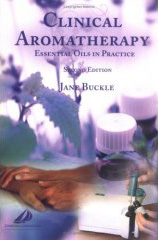IJCH Book Review
Written by Deborah Lallier
Published in the International Journal of Caring and Healing, Vol. 6, No. 2, May 2006
Clinical Aromatherapy: Essential Oils in Practice, 2nd ed.
Written by Jane Buckle
 Written to support the use of essential oils in the clinical setting, nurse and author Jane Buckle gives the reader a broad base of researched data from which to apply this complementary therapy. She skillfully discusses the applications of this material to various clinical settings, specialized treatment plans, and hospital departments, with chapters dedicated to pain and inflammation, cardiology, hospice, oncology, and pediatrics, to name only a few.
Written to support the use of essential oils in the clinical setting, nurse and author Jane Buckle gives the reader a broad base of researched data from which to apply this complementary therapy. She skillfully discusses the applications of this material to various clinical settings, specialized treatment plans, and hospital departments, with chapters dedicated to pain and inflammation, cardiology, hospice, oncology, and pediatrics, to name only a few.
While Buckle’s expertise is made clear in the material presented in this book, Buckle supplements her recommendations with data from relevant research studies, giving the reader ample quantitative evidence with experiential support. Throughout the book, research for the use of aromatherapy for specifically named maladies is listed in table format, offering a quick compilation for easy reference. Geared specifically to lead the professional aromatherapist through the myriad of applications of aromatic essential oils, this book warrants textbook status in its field.
The book is divided into two sections, the first of which gives the nature of aromatherapy, its historical roots and modern renaissance, and their extensive clinical properties. This overview describes the physical processes by which aromatherapy works, as well as the various methods of applications and rates of absorption. Buckle describes four methods for absorption of essential oils: topical, internal washes or suppositories, oral, and inhalation.
The intention of this book is to offer an integrative approach which complements and supports traditional healthcare. While the focus is on educating the holistic nurse, massage therapist, and other licensed health professional, Buckle also offers a unique method of application of aromatic essential oils geared for the novice. She terms this the ‘m’ technique consisting of a series of gentle stroking movements, utilizing consistent pressure on the body. This can be easily applied by the layperson. With this technique, patients respond with a reduced heart rate and deep relaxation: “By experiencing each stroke a set number of times, the receiver learns what is going to happen and is lulled into a deep state of relaxation in a very short period of time” (p. 153).
Aromatherapy complements conventional approaches to healthcare, offering a span of application from relaxation to antibacterial properties. Buckle references the Natural Medicines Comprehensive Database of 2002 and summarizes the effectual qualities of the oils. “Essential oils are not just pleasant aromas. Many have specific antibiotic, antiviral, and antifungal properties and have been classified accordingly… In a world where pathogens are mutating faster than synthetic medicines can be created to kill them, essential oils might have a very beneficial role to play. They may even turn out to be the antibiotics of the future” (p. 172).
Another chapter considers the safety concerns of aromatherapy, including toxicity and contraindications. Buckle concludes: “Essentials oils could be important for maintaining antisepsis in operating theaters and for protecting health-care professionals. They are simple to use, considerably less expensive than conventional drugs, have thousands of years of use, have been tested for toxicological effect, have far fewer side effects than conventional drugs, and they smell great!” (p. 193).
The author includes several helpful resources for aromatherapy, including certification programs, safety and health policies and protocols, distributors, useful addresses, databases, and web sites. Virtually every resource available on the subject can be found easily with this book, making it an invaluable and comprehensive aid for the novice, the practitioner, and the researcher within the field.
Throughout the book, Buckle reinforces the need for the care in patient care to be reinstated. Simply taking time with the patient to offer gentleness of the ‘m’ technique or the familiar scent of a favorite fragrance will often place the patient in a great state of reassurance and safety. “Clinical aromatherapy empowers nurses as it allows them to use the art as well as the science of nursing” (p. 119). Clinical Aromatherapy: Essential Oils in Practice offers a valued bridge between conventional healthcare and complementary medicine. This is a foundational must read for those with serious intentions for working with aromatherapy.
Edinburgh: Churchill Livingstone, 2003. 416 pp $39.95 84pp Refs
